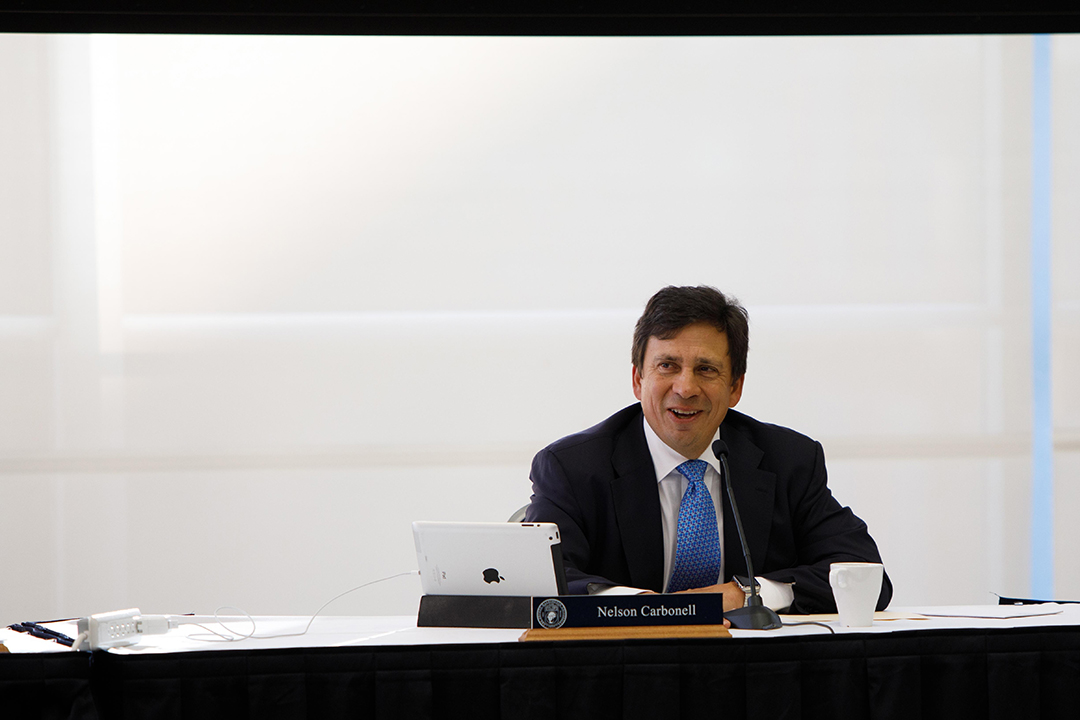The George Washington University Board of Trustees will vote at its Friday meeting to approve a new university mission statement drawn directly from the purposes of GW’s Congressional Charter.
The new statement, which directs the mission of the university as a whole, reads:
“The mission of the George Washington University is to educate individuals in liberal arts, languages, sciences, learned professions, and other courses and subjects of study, and to conduct scholarly research and publish the findings of such research.”
GW Today spoke with Chair of the Board of Trustees Nelson A. Carbonell, Jr., B.S. ’85, about the process for updating the statement and the reasoning behind the recommended language.
Q: Why is GW changing the mission statement?
A: A well governed nonprofit organization periodically reviews its foundational documents to assess the organization’s ability to achieve its goals and accomplish its purpose. For example, the Board of Trustees reviews the university bylaws and faculty code every three years. The last time the university mission statement was updated was more than 20 years ago. It is appropriate now and in the future to include the mission statement in the board’s triennial governing document review.
The Board of Trustees has to be confident in the institution’s ability to achieve its mission. The board’s duties are to the university’s mission including fiduciary duty—duty of care, duty of loyalty, duty of obedience. Upon review, the current mission was too expansive. The Middles States Commission on Higher Education reaccreditation evaluation team’s report confirmed the recommendation that the mission statement be revised.
Q: What is the difference between the mission statement and the university’s aspirational statement as articulated by President LeBlanc?
A: The two serve distinct purposes and complement one another. Whereas the mission explicates what the institution must do, the university’s aspirational statement represents the goal for what the university can do. President LeBlanc articulated an aspirational vision for the university, which was developed through meetings and forums with students, faculty and staff. This aspirational statement is as follows: “Framed by our nation’s capital and inspired by our namesake’s vision, we, the members of the George Washington University, aspire to preeminence as a comprehensive global research university.”
As a companion to that visionary statement, the board looked to the university’s charter for inspiration for a reimagined, more focused mission statement that succinctly articulates the primary role of the university. The revised mission statement is pulled directly from the purposes section of the university’s charter, which was approved by Congress and is our foundational document guiding what we do as an institution.
Q: Does changing the mission statement change what GW does?
A: No, the mission statement is intended to be reflective of what we do as an institution and to be broadly representative of the university.
Q: Why is the Board of Trustees taking the lead on the mission statement?
A: The mission statement is an institutional governing document—similar to the charter and the bylaws of the university—for which the board is responsible.
Q: What was the process for revising the mission statement?
A: The Board of Trustees discussed the update of the mission statement following feedback from the Middle States evaluation team. The Board of Trustees Committee on Governance and Nominations refined the mission statement to the version that the Board of Trustees will consider on Friday. As part of this process, I also discussed the board’s efforts with the Faculty Senate Executive Committee in September and the full Faculty Senate in October as well as with Student Association leadership in the fall.
Q: Is this something that other universities are doing as well?
A: The Board of Trustees Committee on Governance and Nominations looked at our market basket schools and found a variety of approaches, including some that similarly adopted a short and succinct university mission. It is certainly becoming more commonplace today in organizations of all types to have a shorter and more focused mission. In considering how best to act on the feedback of the Middle States evaluation team and of faculty and staff members who participated in that process, we could have taken many different approaches. Ultimately, drawing directly from our charter—our founding document—represents the university’s work at its core across our many schools and disciplines.


